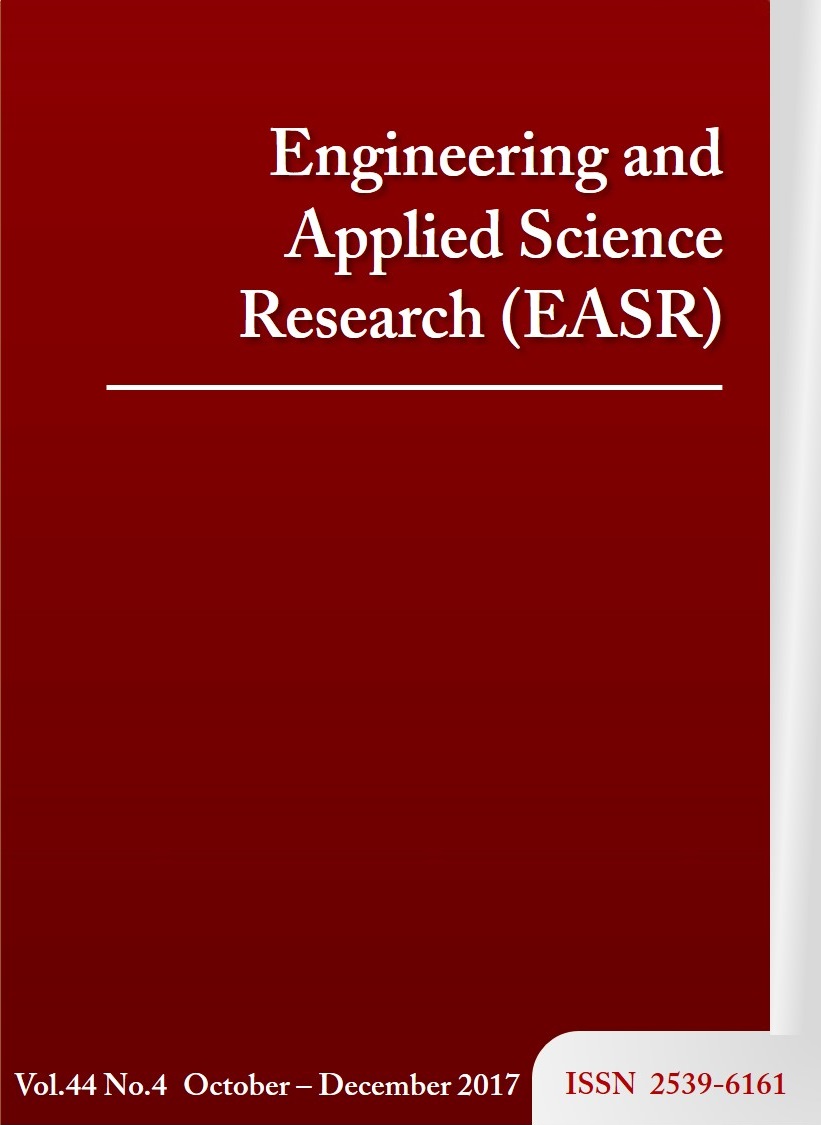Temporal and spatial variability of tropospheric NO2 columns retrieved from OMI satellite data and comparison with ground based information in Thailand
Main Article Content
Abstract
Eight-year’s of satellite data were retrieved from the OMI satellite to investigate temporal and spatial variability of tropospheric NO2 columns during 2008-2015 over 6 regions of Thailand. The highest level of NO2 columns was observed in the central region followed by the eastern, northern, northeastern, and southern regions. Moderately increasing trends of NO2 columns were detected ranging from 16.62% to 39.48% over 7 years (ref. year 2008). In the north and northeast, the maximum levels of NO2 columns were revealed during the biomass burning period of January-April. In the central and eastern regions, the maximum levels were observed during wintertime, i.e., November-February. For the southern region, the west coast showed higher levels during November-April while the east coast showed elevated levels during May-October. Comparative analysis of seasonal patterns of OMI observations versus ground based information of NO2 concentrations and emissions revealed that they were generally in good agreement, particularly in the northern, eastern, and central regions. The results show that relative humidity has an effect on the correlations between OMI data and emissions. Overall, the OMI observations were shown to be useful in tracking atmospheric levels and emission sources of NO2, especially when ground based data are not available.
Article Details
This work is licensed under a Creative Commons Attribution-NonCommercial-NoDerivatives 4.0 International License.
References
van der A RJ, Eskes HJ, Boersma KF, van Noije TPC, Van Roozendael M, De Smedt I, et al. Trends, seasonal variability and dominant NOx source derived from a ten year record of NO2 measured from space. J Geophys Res. 2008;113(D04302):1-12.
Valks P, Pinardi G, Richter A, Lambert JC, Hao N, Loyola D, et al. Operational total and tropospheric NO2 column retrieval for GOME-2. Atmos Meas Tech. 2011;4(7):1491–514.
Richter A, Burrows JP, Nüss H, Granier C, Niemeier U. Increase in tropospheric nitrogen dioxide over China observed from space. Nature. 2005;437(7055):129–32.
Blond N, Boersma KF, Eskes HJ, van der A RJ, Van Roozendael M, De Smedt I, et al. Intercomparison of SCIAMACHY nitrogen dioxide observations, in situ measurements and air quality modeling results over Western Europe. J Geophys Res. 2007;112(D10311):1-20.
Heland J, Schlager H, Richter A, Burrows JP. First comparison of tropospheric NO2 column densities retrieved from GOME measurements and in situ aircraft profile measurements. Geophys Res Lett. 2002;29(20):44-1-44-4.
Lamsal LN, Martin RV, van Donkelaar A, Celarier EA, Bucsela EJ, Boersma KF, et al. Indirect validation of tropospheric nitrogen dioxide retrieved from the OMI satellite instrument: Insight into the seasonal variation of nitrogen oxides at northern midlatitudes. J Geophys Res. 2010;115(D5):1–15.
Geddes JA, Martin RV, Boys BL, van Donkelaar A. Long-term trends worldwide in ambient NO2 concentrations inferred from satellite observations. Environ Health Perspect. 2016;124(3):281–9.
Lalitaporn P, Kurata G, Matsuoka Y, Thongboonchoo N, Surapipith V. Long-term analysis of NO2, CO, and AOD seasonal variability using satellite observations over Asia and intercomparison with emission inventories and model. Air Qual Atmos Heal. 2013;6(4):655–72.
Boersma KF, Eskes HJ, Veefkind JP, Brinksma EJ, van der A RJ, Sneep M, et al. Near-real time retrieval of tropospheric NO2 from OMI. Atmos Chem Phys. 2007;7(8):2103–18.
Levelt P, van den Oord GHJ, Dobber MR, Malkki A, Stammes P, Lundell JOV, et al. The ozone monitoring instrument. IEEE Trans Geosci Remote Sens. 2006;44(5):1093–101.
Boersma KF, Eskes HJ, Dirksen RJ, van der A RJ, Veefkind JP, Stammes P, et al. An improved tropospheric NO2 column retrieval algorithm for the Ozone Monitoring Instrument. Atmos Meas Tech. 2011;4(9):1905–28.
van der Werf GR, Randerson JT, Giglio L, Collatz GJ, Kasibhatla PS, Arellano AF. Interannual variability in global biomass burning emissions from 1997 to 2004. Atmos Chem Phys. 2006;6(11):3423–41.
Lamarque J, Bond TC, Eyring V, Granier C, Heil A, Klimont Z, et al. Historical (1850–2000) gridded anthropogenic and biomass burning emissions of reactive gases and aerosols: methodology and application. Atmos Chem Phys. 2010;10(15):7017–39.
Granier C, Bessagnet B, Bond T, D’Angiola A, van der Gon HD, Frost GJ, et al. Evolution of anthropogenic and biomass burning emissions of air pollutants at global and regional scales during the 1980–2010 period. Clim Change. 2011;109(1–2):163–90.
Diehl T, Heil A, Chin M, Pan X, Streets D, Schultz M, et al. Anthropogenic, biomass burning, and volcanic emissions of black carbon, organic carbon, and SO2 from 1980 to 2010 for hindcast model experiments. Atmos Chem Phys Discuss. 2012;12(9):24895–954.
Fehsenfeld FC, Dickerson RR, Hübler G, Luke WT, Nunnermacker LJ, Williams EJ, et al. A ground-based intercomparison of NO, NOx, and NOy measurement techniques. J Geophys Res. 1987;92(D12):14,710-22.
Hilboll A, Richter A, Burrows JP. Long-term changes of tropospheric NO2 over megacities derived from multiple satellite instruments. Atmos Chem Phys. 2013; 13(8):4145–69.



